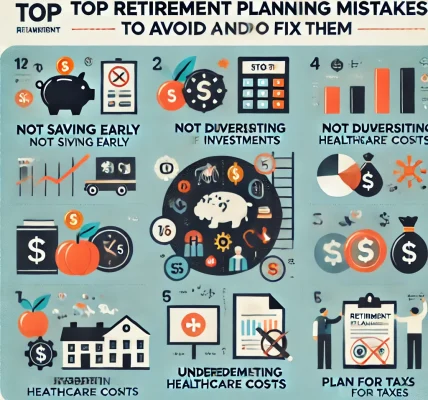Introduction
Retirement planning is essential for everyone, but women often face unique financial challenges that can make it more complex. Factors such as longer life expectancy, career breaks, wage gaps, and caregiving responsibilities can impact a woman’s ability to save effectively for retirement. Despite these challenges, women can secure a financially stable retirement by implementing smart strategies and leveraging available resources.
In this article, we explore the unique challenges women face in retirement planning and offer actionable solutions to help them achieve long-term financial security.
1. Unique Challenges Women Face in Retirement Planning
a) Longer Life Expectancy
Women, on average, live longer than men. According to global statistics, women tend to outlive men by five to seven years. While this is a positive aspect, it also means they need more retirement savings to cover additional years of living expenses, healthcare, and long-term care.
b) Wage Gap and Career Interruptions
Women often earn less than men due to the persistent gender wage gap. Additionally, career breaks for childcare, eldercare, or other family responsibilities lead to reduced lifetime earnings, lower Social Security benefits, and fewer retirement savings.
c) Caregiving Responsibilities
Many women take on caregiving roles for children, aging parents, or spouses. While this is fulfilling, it can limit their ability to work full-time, contribute to retirement plans, and build long-term financial security.
d) Lower Risk Tolerance in Investments
Studies indicate that women are generally more risk-averse investors compared to men. While cautious investing can be beneficial, being too conservative can hinder wealth accumulation over the long term.
e) Lack of Financial Literacy & Confidence
Women often feel less confident in financial decision-making due to a lack of financial education and exposure. This can result in lower participation in employer-sponsored retirement plans or investing in less lucrative options.
2. Key Solutions for Women’s Retirement Planning
a) Start Saving Early & Maximize Contributions
Women should prioritize saving for retirement as early as possible. Contributing consistently to employer-sponsored retirement plans, IRAs, and personal investment accounts can help build a strong financial foundation.
✅ 401(k) Contributions – Take advantage of employer matching contributions. ✅ IRA & Roth IRA – Diversify tax-advantaged retirement savings. ✅ Catch-Up Contributions – Women over 50 can contribute extra funds to retirement accounts to compensate for missed savings years.
b) Invest for Long-Term Growth
Women should strike a balance between conservative investments and growth-oriented assets. Investing in a diversified portfolio of stocks, bonds, real estate, and mutual funds can help generate long-term wealth.
✅ Diversification – Spread investments across multiple asset classes to minimize risk. ✅ Stock Market Participation – Growth-oriented investments help beat inflation. ✅ Financial Advisor Consultation – A professional can guide investment decisions based on long-term goals.
c) Plan for Healthcare & Long-Term Care Costs
Healthcare costs in retirement can be substantial, particularly for women who live longer. Women should consider planning for medical expenses through:
✅ Health Savings Accounts (HSAs) – Tax-advantaged savings for medical expenses. ✅ Long-Term Care Insurance – Helps cover nursing home, assisted living, or in-home care costs. ✅ Medicare & Supplemental Insurance – Understanding coverage options and benefits.
d) Social Security Optimization
Women can maximize their Social Security benefits by strategically planning when to claim benefits.
✅ Delayed Benefits – Waiting until full retirement age (or beyond) increases monthly payments. ✅ Spousal Benefits – Women can claim benefits based on their spouse’s earnings record. ✅ Survivor Benefits – Widows may be eligible for higher benefits based on their deceased spouse’s record.
e) Build Emergency & Passive Income Streams
Having additional income sources can provide security and stability in retirement.
✅ Passive Income – Rental properties, dividend-paying stocks, and side businesses can generate extra income. ✅ Emergency Fund – Saving 6–12 months’ worth of expenses to cover unexpected costs. ✅ Part-Time Work or Consulting – Continuing work in a reduced capacity can supplement retirement income.
f) Financial Education & Empowerment
Women should actively seek financial education through books, workshops, online courses, and financial advisors. Gaining financial confidence allows for better decision-making and long-term wealth building.
✅ Attend Financial Literacy Workshops – Learn investment strategies and retirement planning. ✅ Engage in Money Conversations – Discuss finances with partners, family, or financial planners. ✅ Join Women’s Financial Networks – Leverage resources tailored to women’s financial needs.
3. Special Considerations for Single Women in Retirement Planning
Single women, including divorcees and widows, may face additional challenges when planning for retirement.
📌 Estate Planning – Ensure a legally binding will, power of attorney, and beneficiary designations. 📌 Solo Retirement Planning – Without a spouse’s income, single women need strong personal savings and investment plans. 📌 Legal & Financial Protection – Stay informed about tax laws, pension benefits, and legal rights.
4. Leveraging Employer Benefits & Retirement Programs
Women should take full advantage of employer-sponsored benefits that can help secure a strong retirement.
✅ Pension Plans & Retirement Accounts – Understand employer offerings and maximize contributions. ✅ Employee Stock Purchase Plans (ESPPs) – Participate in programs that provide stock purchase discounts. ✅ Workplace Financial Advisors – Seek guidance from company-sponsored financial planning services.
5. Estate Planning & Wealth Transfer Strategies
Women should plan how they want to pass on their wealth and assets efficiently.
✅ Creating a Will & Trust – Ensure assets are distributed according to their wishes. ✅ Power of Attorney & Healthcare Proxy – Assign trusted individuals for financial and healthcare decisions. ✅ Tax-Efficient Wealth Transfer – Use gifting strategies and trusts to minimize estate taxes.
Conclusion
Women face unique retirement planning challenges, but with proactive financial strategies, they can overcome these obstacles and build a secure future. By prioritizing savings, investing wisely, planning for healthcare costs, and optimizing Social Security benefits, women can enjoy financial independence in retirement.
The key to successful retirement planning is starting early, staying informed, and making smart financial choices. With the right approach, women can create a stable and fulfilling retirement, free from financial worries.




